Mark Anthony Neal's Blog, page 872
August 25, 2013
Hip-Hop’s Anxiety: Inhering Influence, Testimony, & the Test of Time by Wilfredo Gomez
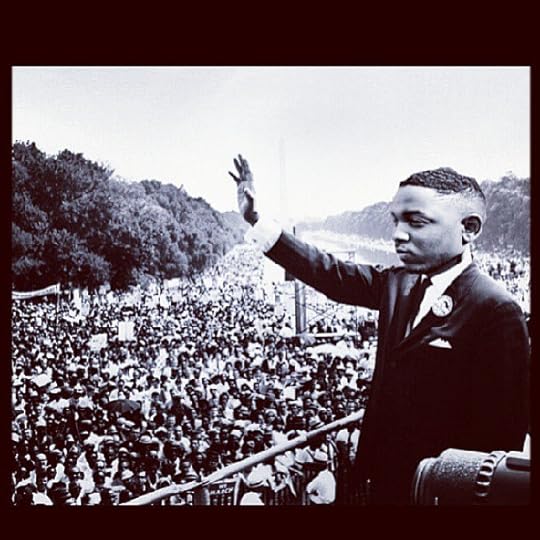 Hip-Hop’s Anxiety: Inhering Influence, Testimony, & the Test of Time
by Wilfredo Gomez | special to NewBlackMan (in Exile)
Hip-Hop’s Anxiety: Inhering Influence, Testimony, & the Test of Time
by Wilfredo Gomez | special to NewBlackMan (in Exile)Yo too many songs/weak rhymes that’s mad long/make it brief son/half short and twice strong—GZA “As High as Wu-Tang Get”
Not this time/but next time/I’mma name names/LL shittin’ from on top of the game/I shot ya—LL Cool J “I Shot Ya”
I throw some ice for the nicest MC/But you can tell Kendrick Lamar/the King of New York is me/Bloomberg—Jasiri X “Mayor Bloomberg Responds to Kendrick Lamar’s Control Verse
“You either die a hero, or you live long enough to see yourself become a villain”—Harvey Dent in The Dark Knight
Before getting into the meat of this piece, take a moment and think about your favorite “diss” song. Do you have some hip-hop quotables? Do they stand the test of time? Which MC’s were at the center of that beef and why? The last quote serving as an epigraph to this piece is poignant on a number of levels, the most obvious one being that Harvey Dent, a symbolic marker of justice in fictitious Gotham City, died as Two-Face, a villain, whose purity and belief in democracy was proof that even the most well-intentioned of individuals was not beyond being corrupted. The line (in the film) that directly proceeds the one cited above tells a tale: one about the presence of enemies at the Roman gates. As Dent narrates, democracy was suspended, thereafter, one man appointed by the people to protect the city, heeds that call, not as an act of valor or honor, but as a public service, a duty.
While Gotham City may just as well be the most famous city in the world, the city that birthed this thing called hip-hop, Harvey Dent is no Kendrick Lamar or Mayor Bloomberg, nor for that matter is Two-Face. It’s been over a week since Hot 97’s resident DJ, Funkmaster Flex debuted the song “Control” by Big Sean featuring Kendrick Lamar and Jay Electronica. The song lasting well over seven minutes, features some pretty sick lines that somehow got lost in the three-minute barrage that was Kendrick Lamar. A title wave of sorts, the verse took hip-hop to task for its lack of creativity and lyrical substance, short-lived lifestyles, fantasies, and images. In the process, Kendrick paid homage to his predecessors and peers, while being critical of the contemporary landscape of hip-hop culture at large.
While debates continue to swirl about those mentioned, implied, and flat out ignored, the likes of J Cole, Big Krit, Wale, Pusha T, Meek Mills, A$AP Rocky, Drake, Big Sean, Jay Electronica, Tyler the Creator, and Mac Miller, were mentioned by name. Since the outing of Lamar's fellow peers, a plethora of artists have countered with their answer via twitter, the blogsphere, and music outlets. Freestyles and reactions have staked their claims and place in hip-hop, while attempting to establish the artist’s lyrical prowess.
The responses read like a who’s who list in the hip-hop game with rejoinders coming from the likes of Joell Ortiz, B.O.B., Joe Budden, Meek Mills, Mac Miller, Iman Shumpert, Ransom, Astro, JR Writer, Lupe Fiasco, Cassidy, Jasiri X, Raekwon, Los, the Mad Rapper, Maino, and Papoose, amongst others, including Kevin Hart and Phil Jackson. The retorts hit a spectrum, from those that applauded Kendrick’s critique as something known to be true, yet gone unspoken, to the flat-out scorn that is deserving of a lyrical uppercut.
Kendrick’s verse, while overshadowing the responses of his peers, in some ways solidifies his rise to prominence as an MC more than capable of flexing some lyrical muscle. However, the verse and its subsequent comeback tracks should serve as a reminder that these intertextual exchanges in direct response to the sonic and poetic canvass(es) crafted by Kendrick are indicative of a much larger issue, an aural signaling of yet another anxious moment in hip-hop culture. To this effect we must ask ourselves as consumers and fans of the culture whether or not these symptomatic expressions of hip-hop’s anxiety are properly situated and contextualized.
Furthermore, do these claims, rooted in and through braggadocio and competition, take hip-hop in any particular direction? Are these responses merely manifestations of play, or are they significant disruptions in the hip-hop arena, more specifically within the stage that is the United States? In what ways do we process, analyze, and critically respond and where might the aftershock be found? Where does hip-hop go from here? What will the context of the next anxious ridden moment? Is there a performance of self and one’s artistic abilities in (mis)regognizing and (mis) reading Kendrick? What might we conclude and find from these questions? In what ways might Kendrick Lamar’s “Control” verse and others serve to reinscribe norms and expectations within hip-hop? These are precisely the kinds of questions that artists, fans, and consumers must answer.
This moment of anxiety, hip-hop’s anxiety is yet another iteration of Nas’ famous, if not controversial claim, announcing the death of hip-hop (side note: other artists such as GP Wu, Outkast, and Talib Kweli, amongst others made similar claims prior to Nas’ album). More broadly the dialogue across the coasts seems to have very little to do with name dropping or claiming allegiances to one’s home coast. The debate is hip-hop’s strawman put out for public show-and-tell, a critical lyrical dialogue about the commercialization of sounds, the pressures of conforming to that sound, how sounds become canonized, and the mass appeal of how sound travels, is imitated, disrupts, and goes ignored.
It is yet again, the anxiety of influence rearing its ugly head in the realm of popular culture, specifically hip-hop. These collective anxieties of influence, propel both fan and artist forward in generating excitement, while (un)intentionally harping back to a nostalgia that cultivates, reinforces, and ultimately fails at constructing a narrative of the authentic vis-à-vis the homage and the newest crop of artists. This unspoken, yet readily acknowledged nostalgia lies dormant in between rhymes as it exposes further arguments about the tangible and intangible qualities that separate hip-hop artists from rappers. A sequel to the Hip Hop is Dead aftermath, Kendrick’s verse is a clarion call to “carry on tradition,” proving still, that MCs are capable of throwing on the suit and mask in bearing the responsibility of being the Dark Knight when the occasion merits it.
***
Wilfredo Gomez is an independent researcher and scholar who can reached via Twitter at @BazookaGomez84 or via email atgomez.wilfredo@gmail.com
Published on August 25, 2013 04:49
August 24, 2013
Trailer: 'The Inevitable Defeat of Mister and Pete' (dir. George Tillman, Jr.)
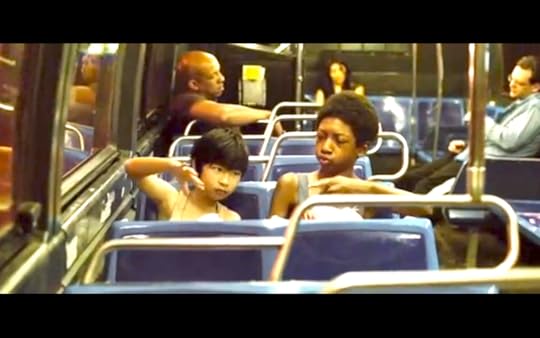 CodeBlackTV
CodeBlackTVFrom Codeblack Films and Lionsgate: During a sweltering summer in New York City, 13-year-old Mister's (Brooks) hard-living mother (Hudson) is apprehended by the police, leaving the boy and nine-year-old Pete (Dizon) alone to forage for food while dodging child protective services and the destructive scenarios of the Brooklyn projects. Faced with more than any child can be expected to bear, the resourceful Mister nevertheless feels he is an unstoppable force against seemingly unmovable obstacles. But what really keeps the pair in the survival game is much more Mister's vulnerability than his larger-than-life attitude.
THE INEVITABLE DEFEAT OF MISTER AND PETE is a beautifully observed and tremendously moving film about salvation through friendship and the way transformation sometimes can happen just by holding on long enough. Director George Tillman, Jr. draws indelible performances from a fantastic cast, which includes Jordin Sparks, Golden Globe® and EMMY®Award winner Jeffrey Wright, Adewale Akinnuoye-Agbaje, Anthony Mackie, and Golden Globe® and Academy Award® winner Jennifer Hudson, all led by Ethan Dizon and Skylan Brooks in a stunning breakout performance as Mister. The film also features new music by Alicia Keys. Codeblack Films and Lionsgate present an iDeal Partners / State Street production in association with Floren Shieh Productions / Archer Gray Productions / Cherry Sky Films / AKW Productions.
Published on August 24, 2013 06:42
August 23, 2013
Beat Making Lab in Fiji: Sampling w/ Flip Flops and Ski Beatz (Episode 3)
 Beat Making Lab | PBS Digital Studios
Beat Making Lab | PBS Digital StudiosA man in Fiji hits a PVC pipe with a flip flop, that sound meets a 17-year-old drummer in North Carolina. A beat is created. And around it all, Platinum selling producer Ski Beatz (producer for Jay Z, Camp Lo and Jay Electronica) lets us know why he even samples in the first place.
Filmmaker: Saleem Reshamwala
Music: Calvin, Fiji Beat Making Lab, Chapel Hill Community Beat Making Lab, No9to5
Filmed at: Oceania Centre for Arts, Culture and Pacific Studies at The University of the South Pacific, Chapel Hill Community Beat Making Lab
Thanks: Dave Lavaki (aka Mr. Grin), Calvin, Dr. Mark Katz, Fiji Beat Making Lab, Pierce Freelon, Saleem Reshamwala, Apple Juice Kid, US Embassy of Fiji
Published on August 23, 2013 14:35
Farm to Table Family: Homemade Granola w/ Orange Blossom Honey Yogurt
 Farm to Table Family | PBS Parents
Farm to Table Family | PBS ParentsHomemade granola is the BEST! I can't say it enough. We go through so much granola in my house. We love it for breakfast with yogurt and fruit, and the kids eat it as a snack regularly. After I started making it myself, I have to say that no store bought granola can compare with this crunchy chunky deliciousness. My kids will find it in the cupboard and eat it right out of the jar. It's so good.
HOMEMADE GRANOLA RECIPE
Ingredients:
2.5 c. rolled oats
1 c. raw nuts (hazelnuts, almonds, etc.)
1 c. dried fruit (cherries, apricots, etc.)
1 tsp cinnamon
1/2 tsp ground ginger
1/2 c. light brown sugar
1/2 tsp salt
1/2 c. unsweetened apple sauce
1 tbsp vegetable oil
1/4 c. honey
1/4 c. maple syrup
1. Preheat oven to 300F
2. Mix the dry ingredients: rolled oats, nuts, cinnamon, ginger, light brown sugar, salt
3. Mix together the wet ingredients in a separate bowl: applesauce, vegetable oil, honey, and maple syrup
5. Combine the wet with the dry ingredients and mix well
6. Spread the granola evenly on a baking sheet
7. Cook for 30 min in the oven, stirring every 10 min
8. Granola done when lightly golden brown
9. Let it cool and it will get crispy and crunchy
9. Optional: Add dried fruit to the dry ingredients before baking if you like the fruit extra chewy, or mix it in at the end after the granola is made
Enjoy!
Published on August 23, 2013 14:24
Lee Daniels’ The Butler Serves a Mixed Plate by Stephane Dunn
 Lee Daniels’ The Butler
Serves a Mixed Plateby Stephane Dunn | special to NewBlackMan (in Exile)
Lee Daniels’ The Butler
Serves a Mixed Plateby Stephane Dunn | special to NewBlackMan (in Exile)Let me just say this at the onset. It would almost be worth an exorbitant movie ticket to see Oprah in just about any movie, rocking a throwback cat suit, shimmying along to Soul Train, telling a no account, trashy “Bitch” to get up out of her house, and slurring Jaaackee [as in Jackie Kennedy]. Such domestic scenes are emerging as one of the trademarks of Lee Daniels’ film style. Daniels uses those intimate, deceptively ordinary moments, the ones when nobody’s watching and we dance or sing alone along with the television or we have at home conversation talking about nothing and everything to kin and friends. Remember Monique’s solo dance in the living room as Precious’s Mama in the film adaptation of the novel PUSH?
The director’s latest offering, Lee Daniels’ The Butler is aptly named with the director’s name within. It should serve as a reminder and cautionary note: The film is not a true story – as some writing and talking about it keep saying. It is more accurate to say the film is inspired by Cecil Gaines [played by Forest Whitaker], the real-life, long time White House butler. Daniels takes on a huge effort and not just because he takes on a real man’s identity but more because he’s made a movie about the twentieth century chapter in American racial history spanning over sixty years. This aim is revealed in the first few moments of the film with two of the first shots, Cecil Gaines back at the White House as a guest in the President Obama era and a photograph of a lynching.
The kaleidoscope of history that the film offers is not a new device of course in Hollywood narrative film, hence Forrest Gump and a number of films before it and since, but it’s very often an awkward affair. The stakes in Lee’s effort to document and celebrate this history are higher too because he knows very well the discomfort that African-Americans have had and continue to have around issues of movie representations – particularly sensitivity over those that feature black folk as servants, maids and butlers. Daniels recognizes this in the film, going as far as having Dr. King address the underlining subversive nobility signified by the dignified service of the black servant. He also attempts to thwart easy dismissals of his film's title character as an Uncle Tom, making sure to include the true story of Gaines' request for equal pay and promotions for the black White House servants.
Lee has competing frames for his story, which emerge dramatically midway through near the end of the film – Gaines and his wife Gloria whose marriage and home life are strained by his long work hours and dedication to the White House – the butler job that allows him to provide well for his family and Gaines and his eldest son Louis (David Oyelowo) who are predictably torn by a generational, Old Negro-New Negro ideological divide. The son becomes a non-violent student activist, freedom rider, Black Panther, and well-intentioned political candidate. The wide socio-political canvas, intended to unfold through Cecil’s life – including his encounters with the presidents he serves like Kennedy, Johnson, Nixon, and Reagan - tries to encompass so much that it overwhelms the narrative and at moments unintentionally reduces the Civil Rights Movement and Black Power to clichéd representations.
Truths of Gaines’ life as a White House butler and the notable events in the Civil Rights and Black Power era don’t altogether harmonize satisfactorily with the fictionalized drama that Daniels employs to fill in the blanks, humanize his characters, and suggest the tensions the turbulent times brings on a family. In the beginning of the film, Cecil witnesses the cold-blooded murder of his sharecropper father and the repetitious abuse of his mother by the same white man then gets taken in as a house servant to serve the man who killed his father. We know wearing the mask in front of white folk, as the White House butlers model to perfection, is a matter of survival, but the dramatic lack of noticeable anger or discomfort or reflection by Gaines throughout and especially in the midst of violent, civil rights struggle is odd.
Gaines’ transformation near the end from a father outraged over his eldest son’s activism and political radicalism to making peace with him and joining his protest after years of estrangement is so abrupt, it doesn’t pack the emotional poignancy that it should. Gloria, lamenting the White House job that keeps her husband away from home and the troubled relationship between her husband and son, develops a drinking problem, and has an affair with a playboy neighbor (Terrence Howard) that seems to begin out of nowhere and end the same way.
There are a number of lighter humorous moments [nod to Cuba Gooding Jr.’s head butler Carter and Elijah Kelly (Charlie Gaines)] and there are some memorable intense sequences. In one, the camera cuts back and forth between historical footage on the television and several dramatic fragments, overlapping shots of the butlers, pristine and invisible in their black and white, perfectly serving the president and White House guests while the son and his girlfriend participate in sit-in training and get beaten at their first Woolworth sit-in then arrested. The film includes fine performances by Forest Whitaker and a solid supporting cast in Winfrey, Gooding Jr., and Lenny Kravitz as well. The glimpses of the butlers intimate lives in the kitchen and so forth, beyond the whites they serve, are some of the most satisfying – though the black female servants are absurdly hardly visible. The presidential casting wavers and actually gets a little hokey but the casting of Joan Fonda as Nancy Reagan - too perfect.
Lee Daniels’ The Butler does not serve history or the life of Gaines seamlessly though it is a well-intentioned effort. It has good timing too, making its debut at exactly the right historical moment, the 50th anniversary of the March on Washington.
***
Stephane Dunn is a writer and Co-Director of the Film, Television, & Emerging Media Studies program at Morehouse College. She is the author of the 2008 book, Baad Bitches & Sassy Supermamas: Black Power Action Films (U of Illinois Press), which explores the representation of race, gender, and sexuality in the Black Power and feminist influenced explosion of black action films in the early 1970s, including, Sweetback Sweetback’s Baad Assssss Song, Cleopatra Jones, and Foxy Brown.
Published on August 23, 2013 08:56
A Praise Song for Bilal by Emily J. Lordi
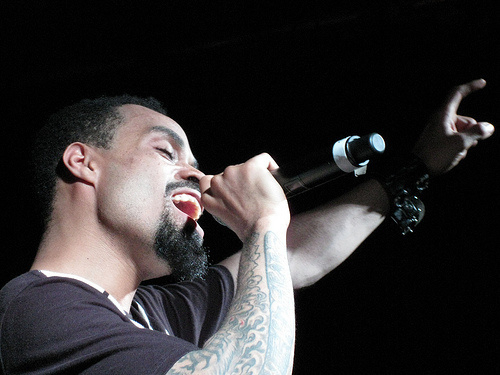 A Praise Song for Bilal
by Emily J. Lordi | special NewBlackMan (in Exile)
A Praise Song for Bilal
by Emily J. Lordi | special NewBlackMan (in Exile)August 23rd is the 34th birthday of musical powerhouse Bilal and as good an occasion as any to offer a praise song for this under-sung singer. There are many reasons why after 12 years in the game Bilal seldom gets the credit he deserves. He has never presented himself as a musical genius, instead cultivating a laidback stoner-meets-the-Mad Hatter vibe; he isn’t young like Frank Ocean, enigmatic like D’Angelo, fabulous like Erykah or all over the scene like the Roots; he records with independent labels and is at heart a collaborator in a system of stars. But he is one of the one of the most brilliant and experimental voices in popular music today. And this year is a good one to celebrate since his album A Love Surreal proved that he’s only getting better with age--deeper into the black musical tradition and consequently further “out.”
We can start with the basic fact of his astounding vocal skills. Studio recordings may never do him justice, but anyone who has seen Bilal perform live will know that he has more technical and imaginative facility than he knows what to do with. Working in the jazz tradition and recalling Billie Holiday’s determination to never sing a song the same way twice, he and his band constantly unhinge song from song form to create new musical space and possibility. At the Prince tribute at Carnegie Hall this year, they transformed Prince’s 90-second incest ode “Sister” into an epic, multi-genre event. But it was at Bilal’s album release show for A Love Surreal that I truly grasped the phrase “talent to burn.” Everything seemed to come so easily that he had to keep pushing new limits--into soaring falsetto, intricate ad-libs, black diamond-level scats traded with his pianist. Hearing this voice without friction, a singer who had to create his own struggle and challenge lest boredom set in, felt like watching someone else’s dream of flying.
What makes Bilal special, in addition to his crazy chops, is that he is a consummate student of black music. A church boy-turned-performing arts school jazz vocalist and arranger who rejects the term “neosoul” as a label used to ghettoize black artists, he variously relates his musical sensibility to jazz, soul, punk, and hip hop. You can hear a whole spectrum of 20th-century music in his work. Sometimes he pays homage overtly by performing at tribute concerts to legends like Curtis Mayfield. But on a deeper level, he weaves a crystalline web of musical influence throughout his work. The voices that come through most clearly are chameleonic talents like Bilal himself: Prince of course, but also David Bowie, George Clinton, Sarah Vaughan. On Love for Sale’s “Make Me Over” from 2006 Bilal makes himself over in the sonic image of about five different singers (to my ear), from John Legend to Sly Stone.
Bilal has defined himself as an artist who moves forward by reaching back since the opening gambit of his 2001 debut, 1stBorn Second. He makes his entrance on that album with a hilarious throwback that winds the hip hop backronym together with the funk radio-DJ conceit: Wake up world, cause we’re about to bring you some more of it… And my name is Bilal, Beloved, Intelligent, Lustful, And Living it..., better known as Pimpin Le Jour… Or, as George Clinton had put it in “P.Funk,” Good evening… We have taken control as to bring you this special show… Welcome to station W-E-F-U-N-K, better known as We Funk, or deeper still, the Mothership Connection… By the end of 1stBorn Second, Bilal changes stations altogether to issue a furious critique of black children’s second-class status scored by Hendrix-style fuzz-heavy chords.
This year’s A Love Surreal turns inward to explore what Toni Cade Bambara called “the inner nation.” Bilal creates an ethereal, psychedelic soundscape through which to chart the complexities of love, from summer flirtations to seductions, laments and recoveries. His allusion to Coltrane’s 1965 masterpiece, A Love Supreme, signals that Coltrane’s spiritual album lights the way for Bilal’s otherworldly work. But I think Coltrane is also a guide because he models meticulous care for tradition. A legendary student of black music, Coltrane would tell an interviewer in 1960 that he had gotten “back to Sidney Bechet already” in his self-directed course of study through the jazz tradition. Bilal’s musical references follow a similar route back through time. When his voice doubles in “West Side Girl,” the resemblance to Prince is uncanny; the sexy ballad “Longing and Waiting” evokes 1970s Marvin Gaye; the refrain of “Astray” recalls the Chi-Lites’ “Have You Seen Her.”
“Slipping Away” is a brutal gem at the album’s center that reveals Bilal’s skills as a lyricist by capturing that moment of lost love when there is nothing more to say but you keep talking. While he begins by noting that your love is slipping away from me, I see it your eyes, I hear it in your voice, Bilal proceeds to cycle through clichés in a helpless attempt to stem the tide: Remember the times we had, before it all went south and fell apart… What can I do to change your mind, talk you back from the ledge?... Don’t jump ship…. The contrast between these empty words and Bilal’s Rick James-style high drama vocals is painful. The album recovers through a beautiful duet with pianist and long-time collaborator Robert Glasper called “Butterfly,” a song that reimagines Kid A-era Radiohead as anthemic instead of anemic: The struggle makes you beautiful, the struggle makes you fly. At a recent show at Harlem’s Marcus Garvey Park, Bilal dedicated this song “to all the hardworking women in the house tonight.” Whatever they did with the monitors made it sound like Bilal’s voice was coming at you through a spaceship.
These stunning moments reveal the meaning of Bilal’s super-chill persona: what he takes seriously is his music, not himself. This explains his willingness to push well beyond the “good” sound, nudging his pout-gritty tenor toward an annoying nasal sneer and leaving it all behind in a song-ripping scream. It is because his commitment to music trumps his ego that he has collaborated with other artists since his Soulquarian days and records guest spots that make everyone else sound better, from Beyoncé to Glasper to Georgia Anne Muldrow. It’s in the service of music that he will run back and forth across the stage in wild moments that only look cool because they’re so uncool. This is the serious play that drives Bilal’s art--play in the theatrical sense that teases drama into quotation marks, hyper-virtuosic play with all aspects of musical form, exalted jam session play with music-nerd friends who speak your hard-won language and can break new rules each time.
The last song on A Love Surreal starts like a blues—woke up this morning—and ends with a call to jump in the flowthat reflects Bilal’s musical ethos. As he told Michael Gonzales, “One of the things I got from jazz is that there are no wrong notes; it’s just the way you view it. You just keep moving forward in the flow, and if you keep your eyes open, you can see the beauty.” The album’s surreal musical trip brings us to a place that is more modest but no less important than Coltrane’s sacred quest, because the destination of this dream is a morning, at once ordinary and profound, when we could wake up and want to start again. In keeping with Bilal’s revisionary art, the last line of the album evokes inheritance, repetition, and generation all at once: Like Grandma used to always say, “Nothing new under the sun.” Nothing really new, maybe, but as Bilal’s music keeps reminding us, so much to work with and so much to love.
***
Emily J. Lordi is an assistant professor of English at the University of Massachusetts, Amherst and writes about contemporary African American literature and black popular culture, especially music. Her first book, Black Resonance: Iconic Women Singers and African American Literature , reveals aesthetic connections between the literary works of Richard Wright, Ralph Ellison, James Baldwin, Gayl Jones, Nikki Giovanni, and Linda Susan Jackson and the vocal art of several iconic women singers: Bessie Smith, Billie Holiday, Mahalia Jackson, Aretha Franklin, and Etta James.
Published on August 23, 2013 05:36
August 22, 2013
Badass Teachers Association (BAT): Statement on 50th Anniversary of March on Washington
 Badass Teachers Association (BAT):
Statement on 50th Anniversary of March on Washington
Badass Teachers Association (BAT):
Statement on 50th Anniversary of March on Washington
The Badass Teachers Association (aka the BATs) is proud to honor the 50th Anniversary of the March on Washington and Dr. Martin Luther King Jr.’s “ I Have a Dream Speech.”
That great movement offered a vision of a nation that would provide freedom and opportunity to all its citizens, and of people of all backgrounds coming together to achieve that goal.
Yet despite great progress and great sacrifice, that dream remains unfulfilled.
It is unfulfilled when more than 25 percent of the children in this country live in Poverty.
It is unfulfilled when we have over 2 million people in prison in the US, most of them poor, many incarcerated for non-violent crimes.
It is unfulfilled when we have a two tier education system- one filled with art, and music and creative thinking for the children of the rich, and one filled with tests, for everyone else.
It is unfulfilled when hundreds of schools in the nation’s poor communities are closed, and those communities destabilized, over the protests of students, teachers and neighborhood residents.
It is unfulfilled when a handful of billionaires shape education policy, completely excluding teacher voices.
It is unfulfilled when the interests of a few profit making corporations take precedence over the needs of children, resulting in testing policies which put students and families under intolerable stress.
We cannot remain silent or complacent in the face of these injustices.
We, the 25,000 plus BATs, pledge to work tirelessly to improve conditions in the nation’s schools and communities, and to make Dr King’s vision a reality in our time.
***
Badass Teachers Association is for every teacher who refuses to be blamed for the failure of our society to erase poverty and inequality, and refuses to accept assessments, tests and evaluations imposed by those who have contempt for real teaching and learning...
Published on August 22, 2013 16:09
Can Twitter Boost Literacy?
Published on August 22, 2013 13:31
August 21, 2013
Episode 4: 'Dream Defenders' Take Over Florida For Trayvon Martin
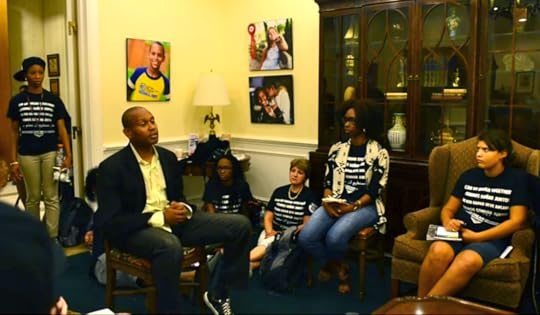 Kevin Powell w/ the Dream Defenders
Kevin Powell w/ the Dream DefendersThe Dream Defenders, a group of student activists in Florida, aren't deterred by Gov. Rick Scott's refusal to hold a special session on the Stand Your Ground Law that allows individuals like George Zimmerman to claim self-defense. Instead, they are taking their cause - and Trayvon Martin's memory - straight to the lawmakers themselves. Watch as they stand their own ground to repeal the controversial protection law that begets violence.
Published on August 21, 2013 08:38
50 Years Later, the Untold History of the March on Washington
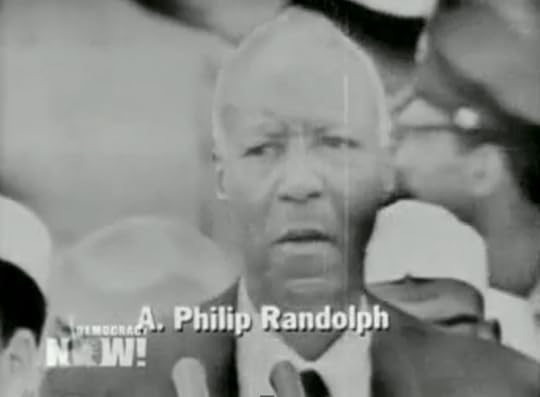 Democracy Now
Democracy NowMore than a quarter-million people came to the nation's capital on August 28th, 1963 to protest discrimination, joblessness and economic inequality faced by African Americans. Many now consider the march to be a key turning point in the civil rights movement.
We explore the largely untold history behind the march and how Dr. Martin Luther King Jr.'s famous "I Have a Dream" speech, like his own political legacy, remains widely misunderstood. "I think today, the way the speech and the march are understood is wrapped in the flag, and seen as one more example of American genius, when in fact it was a mass, multiracial, dissident act," says Gary Younge, author of "The Speech: The Story Behind Dr. Martin Luther King Jr.'s Dream."
Published on August 21, 2013 08:00
Mark Anthony Neal's Blog
- Mark Anthony Neal's profile
- 30 followers
Mark Anthony Neal isn't a Goodreads Author
(yet),
but they
do have a blog,
so here are some recent posts imported from
their feed.




